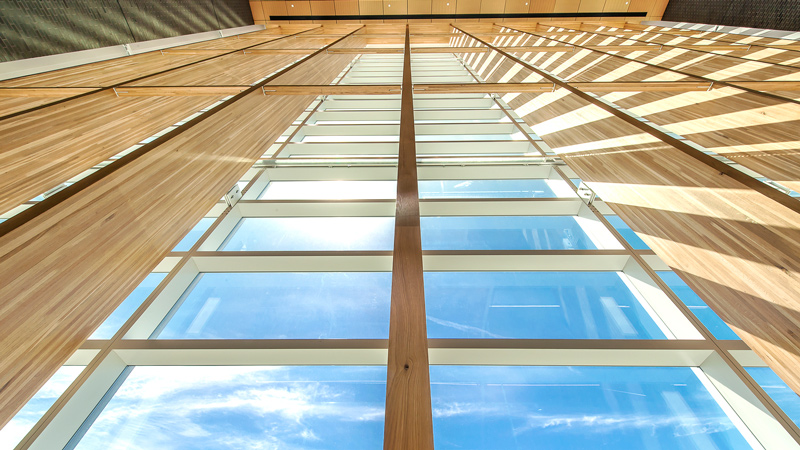Recent Articles
Building a healthier, more equitable world post-pandemic
Chief Sustainability Officer Ellen Mitchell-Kozack advocates for better integration of data and social impact into design

The pandemic has given designers everywhere an opportunity to rethink how we approach our craft. Last week, LEO A DALY’s Global Commercial Practice Leader Kristina Crawley, AIA, NCARB, LEED AP, sat down with Chief Sustainability Officer Ellen Mitchell-Kozack, AIA, and Director of Planning and Urban Design Chia-Lung Chang to discuss how the worldwide health crisis will impact the design of the built environment.
The following is an edited excerpt focusing on Ellen’s thoughts. To read Chia’s half of the conversation, click here.
Prior to the pandemic, commercial workplaces were trending towards health and wellness initiatives like Fitwell and WELL Building. How do you see these trends growing or changing in light of the current health crisis?
It’s true that in the last five years there has been a lot more interest on the client and the tenant side in healthy building programs like WELL and Fitwel, but to be honest, there hasn’t been a huge uptick in actual certifications. I do think that could change, mostly because it’s becoming easier to connect the dots between indoor environmental quality and the underlying conditions that make people more or less susceptible to things like COVID-19.
Sensors and measurements are getting much more sophisticated, and we can now understand indoor environmental conditions beyond just temperature and humidity. We can look at actual particulate matter (PM) and VOC levels to understand what’s happening from an air quality perspective in hard numbers. Same thing with water, same thing with daylighting, with acoustics, and so on. When we start integrating that data into the next generation of design, I expect to see a lot more adoption of those programs.
I attended a presentation years ago from Dr. Claudia Miller, who is the Assistant Dean at the School of Medicine for UT San Antonio, and she said something that was very profound. She said, architects and designers have more impact and influence on public health than medical professionals do. And you know, I think the whole room was a little stunned to hear that. But when you think about it, we spend 90% of our time indoors. And we as architects and designers, were responsible for the quality of that space.
Physical distancing has brought a sharper focus on our need for social connection, and the role of social cohesion in resilience. How does the pandemic change how we look at community and its role in resilience?
When we talk about resilience in the built environment, it largely centers around understanding the natural disasters likely to hit an area, and anticipating those so that we can minimize time without power, or habitability without water and electricity. What the coronavirus pandemic tells us is that we need to be thinking a lot more about how we promote resilience on the community scale. There were some really interesting studies that came out after Hurricane Katrina suggesting that communities with a tighter sense of social cohesion, with more inherent trust in government and civic leaders, were able to rebound faster, regardless of socioeconomic status or proximity to the disaster.
So, the question for designers is, what does social cohesion look like at the urban scale? What design decisions can we make to help foster community? A good place to start is by looking at the AIA framework for Design Excellence. Of the 10 measures in the framework, at least two touch directly on social cohesion. Measure two (Designing for Equitable Communities) is about community engagement and social equity. Measure nine (Designing for Change) is about anticipating the risks associated with climate change at both the building and community scale.
Many of us didn’t have pandemics squarely on our radar in terms of resilience, but we certainly do now. We need to think holistically about what opportunities our clients have to really provide value to communities.
Can you talk about the implications of this disaster on underserved and minority communities and how our decisions in the built environment directly affect social inequality?
It’s been sad to watch how this pandemic has laid bare the social inequalities that we all know exist in our society. Study after study suggest that poorer, minority communities are being hit the hardest, not only by layoffs, but by the virus itself. There are a lot of reasons that is happening, but a piece of it that has to do with the materials that designers specify.
We’ve heard a lot over the last five or six years about the importance of understanding the chemical compositions of building materials like flooring and wall coverings. It’s also important to know the implications of those materials throughout their lifecycle, starting at the manufacturing level, through production, transport, installation and disposal. Are they dangerous to us when they’re in our buildings? And what happens to them when the building gets demolished and they’re in landfills?
There are many different materials certifications, such as environmental product declaration [EPDs] and Cradle to Cradle, to help us make more informed decisions. And there’s a great database called mindful MATERIALS that helps aggregate all of those certifications into a kind of one-stop-shop for assessing products.
It’s equally important to understand how those products, through their lifecycle, affect so-called fenceline communities. Those are communities that live, work and play in the shadows of big industrial manufacturing, whether that’s petrochemical or building materials. The adverse health effects of living in close proximity to those manufacturing plants has been well documented. For example, a stretch of coastline between Baton Rouge and New Orleans has become known as Cancer Alley. There is an extremely high proportion of manufacturing facilities along that coastline, and consequently a much higher incidence of all sorts of diseases, most notably cancer.
When we start to see these poor communities that are getting sicker faster, it’s quite possible that environmental air quality plays some role. And we, as designers, have a choice – understanding what’s happening at a manufacturing level, what’s happening at a disposal level. We now have the tools and the mechanisms to make more informed decisions so that we can move the market and funnel our dollars to companies and manufacturers that are that are producing their materials more responsibly.
Everything we do as designers is for the enrichment of the human experience. How do you think we emerge from this crisis as better designers?
EM: There’s such opportunity for us to design with the planet in mind and with communities in mind. We get so mired down in our business as usual, but it seems like we are rife for really doubling down on a way of working that I think we all aspire to – which is a more integrative and a more holistic process, where we are looking at value added propositions not just for the end users and not just for the client, but for the Earth and for the community. These efforts don’t have to add a penny to the cost of projects – it’s just a matter of front loading the efforts so that we are taking more factors into consideration before we put pen to paper. Everything is connected and interconnected, and the decisions that designers make for one piece ripple down into other pieces. The pandemic has just shone a light on our ability to really influence things beyond just a single building.

Ellen Mitchell-Kozack, AIA, LEED BD+C, WELL AP, SEED is LEO A DALY’s Chief Sustainability Officer. Her goal is to leverage LEO A DALY’s integrated design expertise to affect positive change. She applies a humanitarian and environmental lens to architecture to benefit clients, the communities we live in and the future of our planet.

Kristina Crawley has nearly 16 years of experience in commercial mixed-use, hospitality, retail, restaurant and workplace design in the United States and abroad, including commercial and mixed-use projects from Shanghai to South Korea to Dubai. With a passion for contextual design and placemaking, Kristina has published several articles on resilience, international architectural responses to climate change and post-disaster reconstruction.
